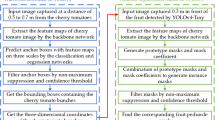Abstract
Pruning is the art of cutting unwanted and unhealthy plant branches and is one of the difficult tasks in the field robotics. It becomes even more complex when the plant branches are moving. Moreover, the reproducibility of robot pruning skills is another challenge to deal with due to the heterogeneous nature of vines in the vineyard. This research proposes a multi-modal framework to deal with the dynamic vines with the aim of sim2real skill transfer. The 3D models of vines are constructed in blender engine and rendered in simulated environment as a need for training the network. The Natural Admittance Controller (NAC) is applied to deal with the dynamics of vines. It uses force feedback and compensates the friction effects while maintaining the passivity of system. The faster R-CNN trained on 3D vine models, is used to detect the spurs and then the statistical pattern recognition algorithm using K-means clustering is applied to find the effective pruning points. The proposed framework is tested in simulated and real environments .
This research is supported in part by the project “Grape Vine Perception and Winter Pruning Automation” funded by joint lab of Istituto Italiano di Tecnologia and Università Cattolica del Sacro Cuore, and the project “Improving Reproducibility in Learning Physical Manipulation Skills with Simulators Using Realistic Variations” funded by EU H2020 ERA-Net Chist-Era program.
Access this chapter
Tax calculation will be finalised at checkout
Purchases are for personal use only
Similar content being viewed by others
References
Adhikari, S., Kandel, T.P.: Effect of time and level of pruning on vegetative growth, flowering, yield, and quality of guava. Int. J. Fruit Sci. 15(3), 290–301 (2015)
Osentoski, S., Jay, G., Crick, C., Pitzer, B., DuHadway, C., Jenkins, O. C.: Robots as web services: reproducible experimentation and application development using rosjs. In: 2011 IEEE International Conference on Robotics and Automation, pp. 6078–6083 (2011)
Russell, S., and Norvig, P.: Artificial Intelligence: A Modern Approach. Pearson Education Limited, Upper Saddle River (2002)
Matas, J., James, S., Davison, A.J.: Sim-to-real reinforcement learning for deformable object manipulation (2018). arXiv preprint arXiv:1806.07851
Wang, Z., Hirai, S.: Modeling and estimation of rheological properties of food products for manufacturing simulations. J. Food Eng. 102(2), 136–144 (2011)
Katyara, S., Ficuciello, F., Caldwell, D., Siciliano, B., Chen, F.: Leveraging Kernelized Synergies on Shared Subspace for Precision Grasp and Dexterous Manipulation (2020). arXiv preprint arXiv:2008.11574
Biagiotti, L., Melchiorri, C., Vassura, G.: Position/force control of an arm/gripper system for space manipulation. In: 2001 IEEE/ASME International Conference on Advanced Intelligent Mechatronics. Proceedings (Cat. No. 01TH8556), vol. 2, pp. 1175–1180 (2001)
Colgate, J.E., Hogan, N.: On the stability of a manipulator interacting with its environment. In: Proceedings of the 25th Allerton Conference Communication Control and Computing (1987)
Newman, W.S.: Stability and performance limits of interaction controllers. J. Dyn. Syst. Meas. Contr. 114(4), 563–570 (1992)
He, L., Schupp, J.: Sensing and automation in pruning of apple trees: a review. Agronomy 8(10), 211 (2018)
Silwal, A., Davidson, J.R., Karkee, M., Mo, C., Zhang, Q., Lewis, K.: Design, integration, and field evaluation of a robotic apple harvester. J. Field Rob. 34(6), 1140–1159 (2017)
Botterill, T., Paulin, S., Green, R., Williams, S., Lin, J., Saxton, V., Corbett-Davies, S.: A robot system for pruning grape vines. J. Field Rob. 34(6), 1100–1122 (2017)
Korayem, M.H., Shafei, A.M., Seidi, E.: Symbolic derivation of governing equations for dual-arm mobile manipulators used in fruit-picking and the pruning of tall trees. Comput. Electron. Agric. 105, 95–102 (2014)
Peng, X.B., Andrychowicz, M., Zaremba, W., Abbeel, P.: Sim-to-real transfer of robotic control with dynamics randomization. In: 2018 IEEE International Conference on Robotics and Automation (ICRA), pp. 1–8 (2018)
Hoffman, E.M., Rocchi, A., Laurenzi, A., Tsagarakis, N.G.: Robot control for dummies: insights and examples using OpenSoT. In: 2017 IEEE-RAS 17th International Conference on Humanoid Robotics (Humanoids), pp. 736–741 (2017)
Faster, R.C.N.N.: Towards real-time object detection with region proposal networks. Advances in neural information processing systems, pp. 91–99 (2015)
Na, S., Xumin, L., Yong, G.: Research on k-means clustering algorithm: an improved k-means clustering algorithm. In: 2010 Third International Symposium on Intelligent Information Technology and Security Informatics, pp. 63–67 (2010)
Mansard, N., Stasse, O., Evrard, P., Kheddar, A.: A versatile generalized inverted kinematics implementation for collaborative working humanoid robots: the stack of tasks. In: 2009 International Conference on Advanced Robotics, pp. 1–6 (2009)
Rocchi, A., Hoffman, E.M., Caldwell, D.G., Tsagarakis, N.G.: OpenSoT: a whole-body control library for the compliant humanoid robot coman. In: 2015 IEEE International Conference on Robotics and Automation (ICRA), pp. 6248–6253 (2015)
Dohring, M., Newman, W.: The passivity of natural admittance control implementations. In: 2003 IEEE International Conference on Robotics and Automation (Cat. No. 03CH37422), vol. 3, pp. 3710–3715 (2003)
Author information
Authors and Affiliations
Corresponding author
Editor information
Editors and Affiliations
Rights and permissions
Copyright information
© 2021 The Author(s), under exclusive license to Springer Nature Switzerland AG
About this paper
Cite this paper
Katyara, S., Ficuciello, F., Caldwell, D.G., Chen, F., Siciliano, B. (2021). Reproducible Pruning System on Dynamic Natural Plants for Field Agricultural Robots. In: Saveriano, M., Renaudo, E., Rodríguez-Sánchez, A., Piater, J. (eds) Human-Friendly Robotics 2020. HFR 2020. Springer Proceedings in Advanced Robotics, vol 18. Springer, Cham. https://doi.org/10.1007/978-3-030-71356-0_1
Download citation
DOI: https://doi.org/10.1007/978-3-030-71356-0_1
Published:
Publisher Name: Springer, Cham
Print ISBN: 978-3-030-71355-3
Online ISBN: 978-3-030-71356-0
eBook Packages: Intelligent Technologies and RoboticsIntelligent Technologies and Robotics (R0)




